+ Open data
Open data
- Basic information
Basic information
| Entry | Database: PDB / ID: 1gnk | ||||||
|---|---|---|---|---|---|---|---|
| Title | GLNK, A SIGNAL PROTEIN FROM E. COLI | ||||||
 Components Components | PROTEIN (GLNK) | ||||||
 Keywords Keywords | SIGNALING PROTEIN | ||||||
| Function / homology |  Function and homology information Function and homology informationpositive regulation of nitrogen utilization / regulation of nitrogen utilization / enzyme regulator activity / ATP binding / identical protein binding / plasma membrane / cytosol Similarity search - Function | ||||||
| Biological species |  | ||||||
| Method |  X-RAY DIFFRACTION / X-RAY DIFFRACTION /  MOLECULAR REPLACEMENT / Resolution: 2 Å MOLECULAR REPLACEMENT / Resolution: 2 Å | ||||||
 Authors Authors | Xu, Y. / Cheah, E. / Carr, P.D. / Vanheeswijk, W.C. / Westerhoff, H.V. / Vasudevan, S.G. / Ollis, D.L. | ||||||
 Citation Citation |  Journal: J.Mol.Biol. / Year: 1998 Journal: J.Mol.Biol. / Year: 1998Title: GlnK, a PII-homologue: structure reveals ATP binding site and indicates how the T-loops may be involved in molecular recognition. Authors: Xu, Y. / Cheah, E. / Carr, P.D. / van Heeswijk, W.C. / Westerhoff, H.V. / Vasudevan, S.G. / Ollis, D.L. | ||||||
| History |
|
- Structure visualization
Structure visualization
| Structure viewer | Molecule:  Molmil Molmil Jmol/JSmol Jmol/JSmol |
|---|
- Downloads & links
Downloads & links
- Download
Download
| PDBx/mmCIF format |  1gnk.cif.gz 1gnk.cif.gz | 53.1 KB | Display |  PDBx/mmCIF format PDBx/mmCIF format |
|---|---|---|---|---|
| PDB format |  pdb1gnk.ent.gz pdb1gnk.ent.gz | 38.8 KB | Display |  PDB format PDB format |
| PDBx/mmJSON format |  1gnk.json.gz 1gnk.json.gz | Tree view |  PDBx/mmJSON format PDBx/mmJSON format | |
| Others |  Other downloads Other downloads |
-Validation report
| Summary document |  1gnk_validation.pdf.gz 1gnk_validation.pdf.gz | 434.9 KB | Display |  wwPDB validaton report wwPDB validaton report |
|---|---|---|---|---|
| Full document |  1gnk_full_validation.pdf.gz 1gnk_full_validation.pdf.gz | 437.3 KB | Display | |
| Data in XML |  1gnk_validation.xml.gz 1gnk_validation.xml.gz | 11.5 KB | Display | |
| Data in CIF |  1gnk_validation.cif.gz 1gnk_validation.cif.gz | 15.5 KB | Display | |
| Arichive directory |  https://data.pdbj.org/pub/pdb/validation_reports/gn/1gnk https://data.pdbj.org/pub/pdb/validation_reports/gn/1gnk ftp://data.pdbj.org/pub/pdb/validation_reports/gn/1gnk ftp://data.pdbj.org/pub/pdb/validation_reports/gn/1gnk | HTTPS FTP |
-Related structure data
- Links
Links
- Assembly
Assembly
| Deposited unit | 
| |||||||||
|---|---|---|---|---|---|---|---|---|---|---|
| 1 | 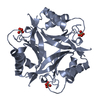
| |||||||||
| 2 | 
| |||||||||
| Unit cell |
| |||||||||
| Components on special symmetry positions |
| |||||||||
| Noncrystallographic symmetry (NCS) | NCS oper: (Code: given Matrix: (0.32092, -0.53527, -0.78134), Vector: |
- Components
Components
| #1: Protein | Mass: 12276.192 Da / Num. of mol.: 2 / Source method: isolated from a natural source / Source: (natural)  #2: Chemical | #3: Water | ChemComp-HOH / | |
|---|
-Experimental details
-Experiment
| Experiment | Method:  X-RAY DIFFRACTION / Number of used crystals: 1 X-RAY DIFFRACTION / Number of used crystals: 1 |
|---|
- Sample preparation
Sample preparation
| Crystal | Density Matthews: 2.4 Å3/Da / Density % sol: 45 % | ||||||||||||||||||||||||||||||
|---|---|---|---|---|---|---|---|---|---|---|---|---|---|---|---|---|---|---|---|---|---|---|---|---|---|---|---|---|---|---|---|
| Crystal grow | pH: 6.5 / Details: 30% MPD, 0.2M CH3COONH4, 0.1M CACODYLATE, PH 6.5 | ||||||||||||||||||||||||||||||
| Crystal | *PLUS | ||||||||||||||||||||||||||||||
| Crystal grow | *PLUS Temperature: 277 K / Method: vapor diffusion, hanging dropDetails: Macpherson, K.H.R., (1998) Acta Crystallog. sect., D54, 996. | ||||||||||||||||||||||||||||||
| Components of the solutions | *PLUS
|
-Data collection
| Diffraction | Mean temperature: 100 K |
|---|---|
| Diffraction source | Source:  ROTATING ANODE / Type: RIGAKU RU200 / Wavelength: 1.5418 ROTATING ANODE / Type: RIGAKU RU200 / Wavelength: 1.5418 |
| Detector | Type: RIGAKU RAXIS II / Detector: IMAGE PLATE / Date: Nov 15, 1996 |
| Radiation | Protocol: SINGLE WAVELENGTH / Monochromatic (M) / Laue (L): M / Scattering type: x-ray |
| Radiation wavelength | Wavelength: 1.5418 Å / Relative weight: 1 |
| Reflection | Resolution: 2→25 Å / Num. obs: 14384 / % possible obs: 99.8 % / Redundancy: 6.8 % / Rmerge(I) obs: 0.047 |
| Reflection shell | Resolution: 2→2.07 Å / Rmerge(I) obs: 0.182 |
| Reflection | *PLUS Num. measured all: 97474 |
- Processing
Processing
| Software |
| ||||||||||||||||||||||||||||||||||||||||||||||||||||||||||||
|---|---|---|---|---|---|---|---|---|---|---|---|---|---|---|---|---|---|---|---|---|---|---|---|---|---|---|---|---|---|---|---|---|---|---|---|---|---|---|---|---|---|---|---|---|---|---|---|---|---|---|---|---|---|---|---|---|---|---|---|---|---|
| Refinement | Method to determine structure:  MOLECULAR REPLACEMENT / Resolution: 2→6 Å / Data cutoff low absF: 15 / Cross valid method: THROUGHOUT / σ(F): 2 MOLECULAR REPLACEMENT / Resolution: 2→6 Å / Data cutoff low absF: 15 / Cross valid method: THROUGHOUT / σ(F): 2
| ||||||||||||||||||||||||||||||||||||||||||||||||||||||||||||
| Displacement parameters | Biso mean: 24 Å2 | ||||||||||||||||||||||||||||||||||||||||||||||||||||||||||||
| Refinement step | Cycle: LAST / Resolution: 2→6 Å
| ||||||||||||||||||||||||||||||||||||||||||||||||||||||||||||
| Refine LS restraints |
| ||||||||||||||||||||||||||||||||||||||||||||||||||||||||||||
| LS refinement shell | Resolution: 2→2.07 Å / Total num. of bins used: 10
| ||||||||||||||||||||||||||||||||||||||||||||||||||||||||||||
| Xplor file | Serial no: 3 / Param file: PARHCSDX.PRO / Topol file: TOPHCSDX.PRO | ||||||||||||||||||||||||||||||||||||||||||||||||||||||||||||
| Software | *PLUS Name:  X-PLOR / Version: 3.01 / Classification: refinement X-PLOR / Version: 3.01 / Classification: refinement | ||||||||||||||||||||||||||||||||||||||||||||||||||||||||||||
| Refinement | *PLUS Lowest resolution: 6 Å / σ(F): 2 / % reflection Rfree: 10 % | ||||||||||||||||||||||||||||||||||||||||||||||||||||||||||||
| Solvent computation | *PLUS | ||||||||||||||||||||||||||||||||||||||||||||||||||||||||||||
| Displacement parameters | *PLUS Biso mean: 24 Å2 | ||||||||||||||||||||||||||||||||||||||||||||||||||||||||||||
| LS refinement shell | *PLUS Rfactor Rfree: 0.276 / % reflection Rfree: 6.3 % / Rfactor Rwork: 0.242 |
 Movie
Movie Controller
Controller



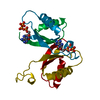
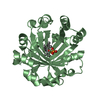

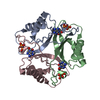


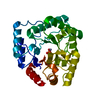

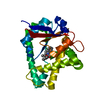

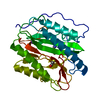
 PDBj
PDBj


